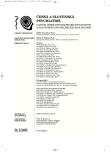Disorders of Perception in Anxiety Conditions
Authors:
E. Garajová; V. Garaj
Authors‘ workplace:
Psychiatrické oddelenie NsP, Bojnice
; Pedopsychiatrická ambulancia, Prievidza
Published in:
Čes. a slov. Psychiat., 104, 2008, No. 8, pp. 412-414.
Category:
Original Article
Overview
Presence of the qualitative disorders of perception in pedopsychiatric patients constitutes a diagnostic problem.. Because of child’s mental immaturity the critical view, the important factor in the judgement of qualitative disorders of perception, - causes that the diagnostic process is often incorrect. Evidence of qualitative disorders of perception is not obliged to diagnose psychotic disorder, namely schizophrenia. The symptom needs to be evaluated in the context of the other disorders of mental functions. The group of 42 pedopsychiatric patients with the diagnosis of anxiety disorder, in witch the qualitative disorders of perception evidenced, is presented. The patients were followed for more than 3 years. Psychotic disorder was not developed in any of them, but there were abnormal personality features in some of them. The most differentially diagnostic problem was in the patients with posttraumatic stress disorder.
Key words:
hallucinations, anxiety disorders, long-term observation.
Sources
1. Altman, H. Collins, M. Mundy, P.: Subclinical hallucinations and delusions in nonpsychotic adolescents. L. Child. Psychol. Psychiatry, 38, 1997, 4, pp. 413-420.
2. Dahmen, N., Kasten, M., Mittag, K., Muller, M. J.: Narcoleptic and schizophrenic hallutinations. Implications for differential diagnosis and pathophysiology. Eur J. Health Econ., 2002, 3, Suppl 2, pp. S94-S98.
3. Dhosse et al.: Diagnostic outcome of self-reported hallucinations in a community sample of adolescents. Psychol. Med., 32, 2002, 4, pp. 619-627.
4. Edelsohn, G. A., Rabinovich, H., Portnov, R.: Hallucinations in nonpsychotic children: finding from a psychiatric emergency service. Ann N Y Sci., 2003, 1008, pp. 261-264.
5. Garralda, M. E.: Hallucinations in children with conduct and emotional disorders II. The follow up study. Psychol. Med.,14, 1984, 3, pp. 597-604.
6. Garrett, M., Silva, K.: Auditory hallucinations, source monitoring and the belief that „voices“ are real. Schizophr. Bull., 29, 2003, 3, pp. 445-457.
7. Hems, I. et al.: Persisting hallutinations following childhood sexual abuse. Aust. N Z Psychiatry, 24, 1990, 4, pp. 561-565.
8. Hlastala, S. A., McClellan, J.: Phenomenology and diagnostic stability of youth with atypical psychotic symptoms. J. Child. Adolesc. Psychopharmacol., 15, 2005, 3, pp. 497-509.
9. Pao, M. et al.: Visual, tactile and phobic hallkucinations: recognition and management in the emergency department. Pediatr. Emerg. Care, 20, 2004, 1, pp. 30-34.
10. Seedat, et al.: Linking posttraumatic stress disorder and psychosis: a look at epidemiology, phenomenology and treatment. J. Nerv. Ment. Dis., 191, 2003, 10, pp. 675-681.
11. Schreier, H. A.: Auditory hallucinations in nonpsychotic children with affective syndromes and migraines: report of 13 cases. J. Child. Neurol., 13, 1998, 8, pp. 377-382.
12. Shevlin, M., Dorahy, M, Adamson, G.: Childhood traumas and hallucinations: An analysis of the National Comorbidity Survey. J. Psychiatr. Res., 2006.
13. Sosland, M. D., Edelsohn, G. A.: Hallucinationms in children and adolescents. Curr Psychiatry Rep., 7, 2005, 3, pp. 180-188.
14. Staver, C. et al.: Looking for childhood schizophrenia: case series of false positives. J. Am. Acad. Child. Adolesc. Psychiatry, 43, 2004, 8, pp. 1026-1029.
15. Yoshizumi, T. et al.: Hallucinatory experiences in a community sample of Japanese Children. J. Am. Acad. Child. Adolesc. Psychiatry, 43, 2004, 8, pp. 1030-1036.
Labels
Addictology Paediatric psychiatry PsychiatryArticle was published in
Czech and Slovak Psychiatry

2008 Issue 8
- Memantine in Dementia Therapy – Current Findings and Possible Future Applications
- Hope Awakens with Early Diagnosis of Parkinson's Disease Based on Skin Odor
- Memantine Eases Daily Life for Patients and Caregivers
- Deep stimulation of the globus pallidus improved clinical symptoms in a patient with refractory parkinsonism and genetic mutation
Most read in this issue
- Application of Standardized Evaluating Scales in the Nursing Process in Psychiatry
- Borna Disease Virus (BDV) and Psychical Disorders
- The Position of Milnacipran in Clinical Practice
- Possibilities of Evaluation and Scaling Aggressiveness in Psychiatric Patients by Means of Personality Questionnaires
